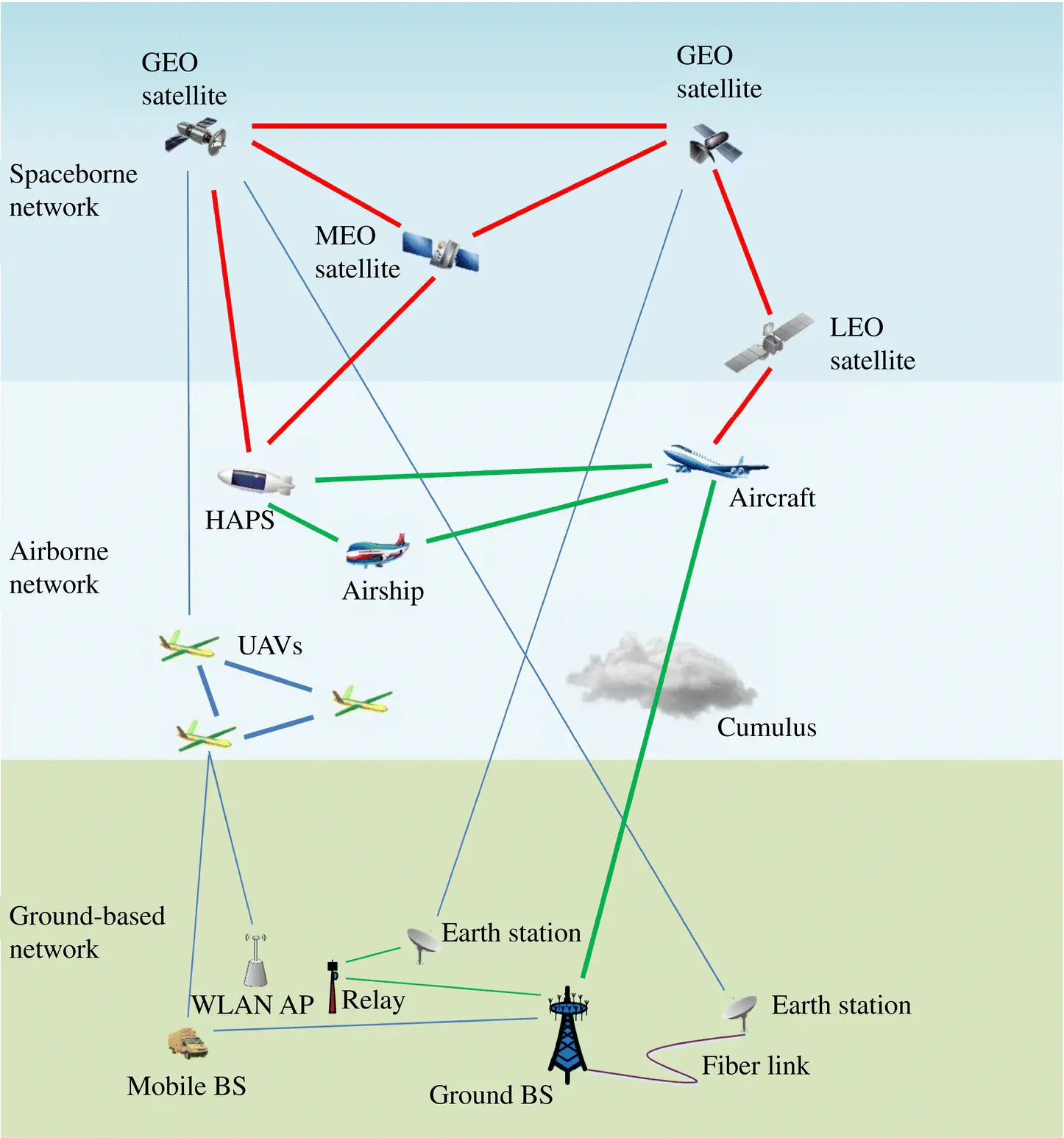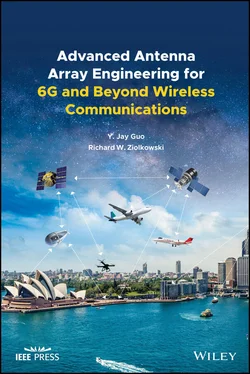c) Employ Beam Testers
Beam testers are effectively flexible beamforming networks. By connecting a beam tester to an antenna array, one can test a variety of the beams defined by the beam tester using a traditional method for antenna pattern testing. The 3rd Generation Partnership Project (3GPP), which unites seven telecommunications standard development organizations (ARIB, ATIS, CCSA, ETSI, TSDSI, TTA, and TTC), has defined three Over‐the‐Air (OTA) test methods for MIMO antennas: the direct far‐field (DFF) method using a far‐field chamber, the indirect far‐field (IFF) method using a compact range, and the near‐field to far‐field transform (NFTF) method using a near‐field chamber. All three OTA approaches are conventional methods familiar to antenna engineers.
It must be recognized that when active electronics are added to a radiating aperture to form a MIMO antenna, the antenna ports are now embedded in the system. As a result, it becomes much more difficult to measure the true gain and antenna efficiency. Because a massive MIMO antenna has a large number of antenna elements and its radiating aperture can be excited in many ways to create different beams, both narrow and broad, it is truly difficult to fully test and validate beam performance in terms of conventional figures of merit, e.g., pattern characteristics, beam shapes, beam steering, side lobe levels, and null locations. Testing is further complicated because measurements for both the transmit case and the receive case must be performed to understand the operating characteristics of both RF chains.
To facilitate the manufacturing and adoption of large antenna arrays in 5G and beyond systems, the wireless industry is pushing to increase the level of integration of the system frontend modules (FEM). Figure 1.2shows the AiP roadmap of the TMY Technology (TMYTEK) company for their 5G mm‐wave products [9]. Each enclosure block represents one particular level of component integration. The industry trend is to integrate the antenna arrays with all of the radio frequency (RF) and intermediate frequency (IF) modules into one package. Characterization of all of the beams produced by such modules is undoubtedly a new challenge for antenna designers.

Figure 1.2 Three levels of AiP implementation by TMYTECH.
Source : From [9] / with permission of TMY Technology Inc.
1.2 6G and Its Antenna Requirements
5G mobile and wireless systems are ground‐based. Consequently, they have coverage requirements similar to earlier generations of terrestrial networks. In contrast, space‐communication networks provide vast coverage for people and vehicles at sea and in the air, as well as in remote and rural areas. They are complementary to terrestrial networks. Clearly, future information networks must seamlessly integrate space networks with terrestrial networks to achieve significant advances beyond 5G. This integrated wireless ecosystem may become one of the most ambitious targets of 6G systems [10]. It is currently envisaged that 6G wireless systems will support truly global wireless communications, anywhere and anytime. An integrated space and terrestrial network (ISTN) is expected to be at the core of beyond 5G communication systems. As a consequence, the development of the technologies to achieve a high‐capacity, yet low‐cost, ISTN is of significant importance to all of the emerging 6G wireless communication systems.
Currently, there are a number of commercial and government spaceborne and airborne platforms that support various applications in communications and sensing. These include geostationary Earth orbit (GEO), medium Earth orbit (MEO), and low Earth orbit (LEO) satellites. As their names indicate, they operate at different altitudes relative to the Earth’s center. Various airborne platforms also operate at different altitudes such as high‐altitude platforms (HAPs), airplanes, and unmanned aerial vehicles (UAVs, otherwise known as drones). It is anticipated that any eventual 6G and beyond mobile wireless communication networks will thus consist of three network layers, namely the space network layer, the airborne network layer, and the terrestrial network layer. An illustration of a potential ISTN architecture is shown in Figure 1.3. Figure 1.3clearly suggests that there will be a huge number of dynamic nodes constituting the mobile airborne networks, in addition to the dynamic nodes of the ground and space (satellite) networks [10].

Figure 1.3 An illustration of a potential ISTN architecture for 6G and beyond.
Source : From [10] / with permission of IEEE.
Airborne networks have a number of unique characteristics. First, most of their nodes would have multiple links to achieve network reliability, high capacity, and low latency. Second, most of them will be mobile. Therefore, both their network links and topologies will vary with time, some faster than others. Third, the distances between any two adjacent nodes will vary significantly, from hundreds of meters to tens of kilometers. Fourth, the power supplied to any node would be limited. Consequently, as in the case for terrestrial networks, the energy efficiency of each node not only impacts the operation costs, but also the commercial viability of the entire network. Fifth, it is highly desirable for antennas on most airborne platforms to be conformal in order to meet their aerodynamic requirements and to maintain their mechanical integrity.
All of the noted, desirable ISTN features pose a number of significant and interesting challenges for future 6G antennas and antenna arrays. The antennas, for example, must be compact, conformal, and high‐gain. They must be reliable, lightweight, and low‐cost. The corresponding arrays must provide individually steerable multiple beams; dynamic reconfiguration of their patterns, polarizations, and frequencies to cope with the movement of the platforms; and overall high energy efficiency. The biggest challenge among all of them is arguably the reduction of the overall energy consumption. One promising solution is to employ analog steerable multi‐beam antennas. Hybrid beamforming is another. Since beamforming and beam scanning can be done by antenna reconfiguration through electronic switching or tuning, the energy required is negligible in comparison to employing a full digital beamforming approach.
1.3 From Digital to Hybrid Multiple Beamforming
There are several ways to form multiple beams from an array. Major schemes can be categorized into digital, analog, and crossover strategies. We begin by describing digital beamforming and a major crossover of much recent excitement, hybrid beamforming.
1.3.1 Digital Beamforming
Given an antenna array, digital beamforming is the ultimate way to achieve optimal performance. It is the most flexible approach to generating individually steerable and high‐quality multiple beams. With a single antenna array of large enough size and the same set of RF circuits, one can effectively create as many beams as desired by applying different complex weights (amplitude and phase) to each element of the array in the digital domain. More advanced digital beamforming schemes employ algorithms such as eigen‐beamforming to obtain the maximum SINR values [11]. Fully digital beamforming with massive antenna arrays serves as a powerful technology to meet some of the most challenging desired features of future wireless communication networks including capacity, latency, data rates, and security.
Читать дальше














